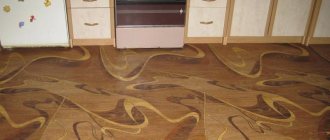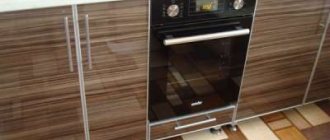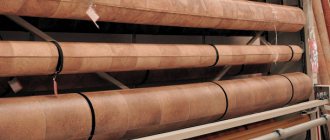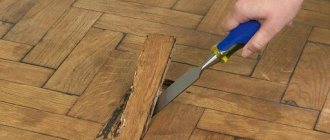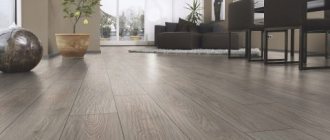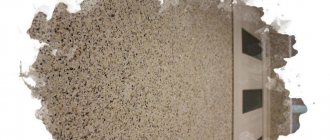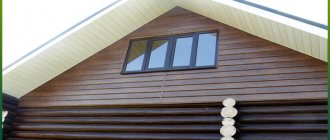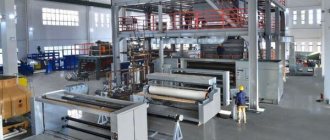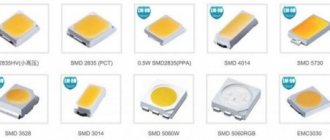Pros and cons of linoleum
Disputes about the benefits and harms of linoleum began and continue to this day.
The development of production with new technologies and product quality control would seem to leave no doubt about the safety and environmental friendliness of materials. The abundance of patterns, textures and varieties of linoleum floor sheets allows you to embody any design ideas.
The disadvantages of the material include the following factors:
- Before laying the covering, you need to level the floor to prevent subsequent warping or cracking of the linoleum;
- in case of rearranging pieces of furniture, marks on the surface from the legs and dents are possible;
- the use of synthetic components, although in modern production standards for sanitation and hygiene are observed.
The analysis of the pros and cons reflects the convincing advantages of the properties of linoleum, which provide consumers with comfort.
The photo shows one of the possible disadvantages of covering the floor with linoleum
What is PVC linoleum made of?
As the name suggests, its main component is the already mentioned polyvinyl chloride mixed with plasticizers, which include lime flour and various pigments. In order to reduce its cost, limestone, talc and kaolin are also added. However, an important point is the exact observance of proportions, since the slightest excess of additional components significantly affects the quality, which can be detected already during operation. A little later we will look at how this happens, the main reasons and how to avoid it.
In general, PVC linoleum, produced by a reliable manufacturer, has excellent consumer qualities, including heat and sound insulation protection. Its disadvantages include a high degree of shrinkage.
Criterias of choice
When choosing a material, special attention must be paid to the quality of the top and bottom layers. In order for the coating to last a long time, it is recommended to purchase linoleum with a protective layer of at least 0.6 millimeters
To maintain heat in the room and increase sound insulation, you need to buy material with a thick backing.
To transport it, you need a vehicle in which the roll can be placed vertically
It is important to store the material at a distance of at least 1 meter from heating devices, in rooms with normal humidity levels. It is unacceptable for linoleum to be near organic solvents.
Types of linoleum
To understand which linoleum is best for an apartment, you need to understand its varieties. Knowing the advantages and disadvantages of each, you can choose the necessary product without being disappointed later.
Natural linoleum
Natural linoleum contains only harmless components. In addition to the jute fabric base, pine resins, cork and wood flour, linseed oil, lime powder, and natural dyes are used in the production of such products. The use of such coatings is acceptable even in children's rooms. It is also safe for allergy sufferers.
Components found in natural linoleum
Advantages:
- compliance with environmental standards;
- bactericidal properties of the material;
- abrasion resistance;
- does not fade over time;
- does not fade in the sun;
- does not support combustion;
- variety of colors;
- ease of use.
Flaws:
- not resistant to moisture, which is why it is not advisable to lay it in the kitchen and hallway;
- when linoleum is bent, cracks may appear on the surface; this should be taken into account when transporting and working with the product;
- quite high price compared to artificial linoleums.
PVC (polyvinyl chloride) linoleum
The main binder in PVC linoleums is polyvinyl chloride. The product also contains plasticizers, fillers, stabilizers and dyes.
Advantages:
- antistatic coating;
- low thermal conductivity;
- moisture resistance;
- ease of installation;
- environmental Safety;
- variety of colors.
Flaws:
- instability to alkalis and solvents;
- shrinks after laying;
- When exposed to low temperatures, the elasticity of the material decreases, which can lead to cracking.
PVC linoleums come with a base (fabric, non-fabric, foam), without a base, single-layer, multi-layer
According to purpose, PVC linoleum is divided into:
- Domestic. The thickness of household linoleum is 1-4 mm. It may have a polyester or foam base. The service life of household PVC linoleum is no more than 5 years;
- Commercial. Commercial linoleum has a very high degree of wear resistance. It has a very thick protective layer. It is used in office and work areas. The service life of commercial linoleum is 1-25 years;
- Semi-commercial. The structure of semi-commercial linoleum is similar to household linoleum, but has a thickened protective layer (up to 0.7 mm). It is laid in apartment rooms with the highest traffic (kitchens, hallways), and in office premises with low traffic. The service life of semi-commercial linoleum is 7-20 years;
- Specialized. This linoleum is developed for specific tasks. Sports - covered with a polyurethane layer that improves wear resistance. Bactericidal - contains antifungal and antibacterial additives. Anti-slip - thanks to the quartz chips added to it, it has a relief surface. Sound-absorbing – has a thickened base.
Glypthal
Glyphthalic linoleum is made by applying alkyd resin to a fabric base. Before laying it, the product should lie in a warm room. So that after installation it does not become deformed.
Advantages:
- increased thermal insulation;
- increased sound insulation.
Flaws:
- fragility of the material;
- difficulty of installation due to the possibility of cracks.
Colloxylin
Colloxyline linoleum is a baseless single-layer floor covering.
It is made from wood or cotton cellulose nitrate, plasticizers, fillers, stabilizers.
Advantages:
- moisture resistance;
- flexibility (maintains even at low temperatures);
- elasticity.
Flaws:
- risk of shrinkage;
- instability to organic solvents, alkalis, acids;
- high heat absorption coefficient;
- reacts to temperature changes.
Linoleum relin
Relin linoleum is a two-layer flooring material.
The top layer is rubber made from natural rubber, which has increased strength and hardness. The bottom layer is rubber based on styrene rubber, which has medium hardness and improves the shock-absorbing properties of the material.
Advantages:
- low slip level;
- good shock-absorbing properties;
- firmness and elasticity.
Flaws:
- high thermal conductivity;
- instability to solvents;
- the presence of harmful substances that evaporate over time.
Main types of linoleum
Linoleum is usually divided into household, commercial, semi-commercial, as well as natural and synthetic. We will try to outline the main pros and cons of each type.
Household linoleum is made on a foam base and a polyester base. The thickness of the strip varies between 1 and 4 mm. At the same time, household linoleum has a rather complex structure.
A variety of colors and designs, softness, water resistance, ease of installation and care, as well as low price attract the attention of buyers. But the service life of household linoleum under intense load is no more than two years
Dents easily form on it, so it is advisable for owners of this coating to purchase furniture with wide legs, and when moving sofas and cabinets, lift them. Considering all of the above, it is recommended to use household linoleum only in residential premises.
The main advantage of commercial linoleum is its relative durability and wear resistance. This is an ideal option for offices and salons, since it is quite possible to apply a company logo or any other design to it. Depending on the composition and production technology, commercial linoleum is divided into homogeneous and heterogeneous.
Homogeneous linoleum is a panel with a thickness of 1.5 to 3 mm with a monochromatic pattern. It contains limestone, talc, and kaolin. If the technical conditions are not met, fillers may come to the surface, forming a dirty coating. Therefore, during production, special polyurethane protection is applied to linoleum. The only drawback of such a protective coating is the need to sand it down every 3-6 months.
Heterogeneous linoleum is a truly universal material. Its structure is multi-layered. The basis of these coatings is fiberglass. The front side of the material is impregnated with PVC paste. Another layer of PVC is applied on top of the first layer. Next, the surface of the linoleum is decorated with a pattern, which is secured using another layer of PVC, transparent and very durable. The reverse side of the fiberglass base is equipped with a backing - either fabric, jute, or foamed PVC. To care for heterogeneous linoleum, wet cleaning is sufficient.
Semi-commercial linoleum is similar in structure to household linoleum (base, decorative layer, protective layer). A distinctive feature of this type is the increase in the thickness of the protective layer (up to 0.7 mm). It is used in office and public spaces, as well as in passageways and living rooms.
The advantages of synthetic linoleum include ease of care: it is quite easy to clean, and you are not afraid to spill water on it. In addition, it has high noise-absorbing ability. But this coating has many more disadvantages.
In the production of synthetic linoleum, toxic resins are used that can be released into the atmosphere. Xylene and toluene, which are included in its composition, irritate the eyes, cause skin diseases and can cause serious disorders in the nervous system. And polyvinyl chloride can decompose even at normal room temperature. It enters the body through inhalation and enters the blood through the skin, causing harmful effects on the liver. Phenol formaldehyde was often found in linoleum, which harms the respiratory system, causes nausea, headaches and can cause the formation of cancer cells. So take care of your health and better buy natural linoleum.
Natural linoleum is absolutely environmentally friendly and harmless. It is resistant to deformation, abrasion and wear. Modern natural linoleum consists of linseed oil, resin, cork flour, limestone powder, natural dyes and jute fabric. Often this type of linoleum is coated with a polymer, but in specialized stores you can purchase natural linoleum without a varnish coating.
The flaxseed oil included in its composition gives it unique bactericidal properties that are not lost over time. In addition, this type of linoleum has sufficient fire resistance; it does not contribute to the spread of flame even in the event of a fire in the room. It is very easy to clean from dust and dirt, both dry and wet.
As for external characteristics, natural linoleum does not fade over time, does not change color, is resistant to fats and ethyl alcohol, and is able to resist non-concentrated acids. Only sharp objects and alkalis can damage it.
It is not recommended to use natural-based linoleum outdoors in places with high humidity.
Linoleum base material
When choosing a floor covering, experts advise paying attention to what kind of base it has - felt or foam. The thicker the base of the linoleum, the stronger it will be and the more it will be able to resist the loads that arise when moving heavy objects.
Typically, stronger material is easy to identify by touch, and the rolls are quite heavy.
To determine a good base, you need to press on the linoleum substrate from below with your finger. It should not bend at the same time. In addition, high-quality material protects the room from extraneous noise and retains heat well.
If the base is well foamed, the floor in the room will be warm enough for walking. Using it you can hide the imperfections of the concrete screed under the coating. A felt-type backing better resists pressure from dresser legs, heavy cabinets, or shoe heels.
Linoleum for the kitchen
Linoleum has an affordable price for many owners, is easy to use, and wears out very slowly compared to other coatings. Laying will not cause difficulties for anyone with minimal construction skills. After covering it with linoleum, the floor surface is well protected from moisture, it is very easy to care for, and the material also copes well with sound insulation and insulation.
An exotic feature of linoleum is its ability to resist dangerous bacteria. Externally, the coating created using linoleum is very presentable and can be shown both in photos and to guests in person. However, today there are a huge variety of varieties of this material on the construction market. Accordingly, you should figure out which linoleum is best for the kitchen and how to choose it correctly so that the coating lasts as long as possible.
Negative points
Despite a number of advantages, ceramics also have disadvantages, which may have moved this material to 3rd place in the ranking:
- First of all, they note the very low temperature of the coating, which is very difficult to correct without a good heating system. It is advisable to install a “warm floor” under the tiles.
- The cost of tiles is much higher. An owner who finds ceramics at a low price should be wary of a fake, which such tiles will most likely turn out to be. Naturally, there can be no talk of any strength characteristics of such products.
- Laying ceramic tiles takes a lot of time, effort and money. It is best to entrust this procedure to a specialist, since a person who does not have certain skills is unlikely to be able to do the job efficiently.
- The coating created when laying tiles creates a risk of injury to residents. Poorly chosen tiles can slip, and a blow to a hard surface can cause injuries of varying severity.
Bottom line
Based on all of the above, we can conclude that linoleum is a coating whose installation in the kitchen is not only undesirable, but even contraindicated. It will be more practical and efficient to use tiles. The owner can only be advised that the choice is based on the criteria of convenience, and not the best design.
The tile must be of high quality, rough or coated with an anti-slip compound, meet the declared characteristics, etc. Installation should be entrusted to a specialist and then you can be sure that the coating will last a very long time without losing its positive qualities over time.
Features of laying felt linoleum
Pile coverings require special attention. It is worth noting that selecting linoleum is not an easy task, because it will be used for a long time. Linoleum has a structure consisting of two cavities: they will determine the properties of linoleum and its performance characteristics.
About felt linoleum
Felt linoleum will be appreciated by people who prefer convenience, coziness and warmth. It has elasticity, softness, and is easy to lay.
However, only a dry room is suitable for using such material, otherwise moisture will destroy the coating from the inside and make it unfit for use. But if the floor covering is subject to heavy loads, most likely, a covering with a fleecy surface will not be able to withstand it. Thus, before purchasing linoleum, you need to take into account all the features of the room in which you plan to install it.
It is better not to use felt linoleum in high-traffic areas
Laying linoleum will not be a problem if you approach this task responsibly and take into account the recommendations of specialists.
Linoleum
| How to choose linoleum | Laying linoleum with your own hands |
| Linoleum care |
Linoleum is a flexible floor covering, which in Western countries is usually called PVC covering. It is made from a synthetic polymer, polyvinyl chloride, with the addition of plasticizers, pigments and various fillers.
Advantages of linoleum:
- relative ease of care,
- wide distribution of various models and colors,
- softness and elasticity,
- strength,
- high abrasion resistance,
- low level of deformation.
There are two types of linoleum, homogeneous and heterogeneous. The name is given depending on the composition and production technology.
Homogeneous linoleum is a homogeneous fabric made by rolling on calenders, i.e. presses with horizontal shafts. The external pattern of such linoleum matches the internal one. It is quite simple, monochromatic, granular.
Due to its durability, such linoleum is usually used in rooms with high loads. For example, in shops, corridors, front doors, etc. Linoleum contains crushed limestone, kaolin or talc. Here, it is important to maintain the required proportion. Thus, linoleums with a high filler content are cheaper than high-quality linoleum.
Heterogeneous linoleum is a canvas consisting of several layers. During production, reinforcing fiberglass is used, which plays the role of a kind of skeleton for the entire canvas as a whole.
The manufacturing process is as follows. Fiberglass is impregnated with PVC paste, then the main front layer of PVC mass is rolled, then a pattern is applied to it using printing cylinders. Finally, a protective transparent polyurethane film is applied. The durability of such linoleum directly depends on the strength and thickness of this film.
Based on the presence or absence of a substrate, linoleums are classified as basic and non-basic. At the same time, homogeneous linoleum is often baseless, and heterogeneous, in most cases, has a backing. The bases are made from different materials, natural and synthetic fabrics, polymer foams, felt.
According to the area of application, linoleums are household, semi-commercial and commercial.
Household linoleum, used in residential premises. It is distinguished by a wide range of design solutions in drawings.
The production of commercial linoleum is accompanied by the addition of corundum to the protective layer. This makes for increased surface adhesion, i.e. Even the slipperiest shoes won't slip on it.
Semi-commercial linoleum occupies a middle position between household and commercial, both in terms of performance and price.
Types of linoleum
Today, there are two types of good linoleum - natural and synthetic.
The natural coating contains linseed oil, which gives it bactericidal properties. In the manufacture of the finished product, only natural ingredients are used: a special homogeneous mass is applied to the jute fibers.
Properties of natural linoleum
- has increased strength and wear resistance;
- antistatic;
- heat resistant;
- not afraid of aggressive environments;
- excellent sound insulation;
- has low thermal conductivity;
- service life is guaranteed for 20 – 40 years.
floor coverings
Synthetic flooring
They are technologically divided into:
// ]]>
Homogeneous.
This material is a polymer layer, uniformly colored throughout its entire depth. Sometimes a protective film is applied to the front layer.
The homogeneous coating lasts a long time, since the pattern is preserved when abraded, which allows it to last in the apartment for about 10-15 years. In addition, this material has antistatic properties, so it is often used in rooms with a large number of electronic equipment.
Heterogeneous.
This material is a complex and multi-modular fabric. The amount of laminate polymer and the thickness of the protective layer in the composition determine the degree of strength and durability of the coating.
Hence, the following types of linoleum are distinguished:
- Household (thickness of the protective cover - 0.1 - 0.3 mm). On the reverse side it is like a sponge with micropores. The facial pattern is applied on top in a thin layer. The material does not stretch or tear. It is mainly laid in apartments or office premises with low traffic.
- Semi-commercial (protective cover - 0.5 - 0.6 mm). In many ways, it is similar to a household one, as it is convenient to use and easy to maintain. But this coating is a little stronger and more resistant to external influences. Suitable for use in public areas with low traffic volume. Choose this linoleum for an apartment with more than 3 people.
- Commercial (protective cover - from 0.6 to 0.8 mm). It has increased strength, is resistant to fire and aggressive environments (household chemicals). This is the best linoleum if you need to cover the floor in buildings with heavy traffic.
When wondering which linoleum is best to buy, it is very important to imagine the approximate cost of the types of flooring materials, so as not to purchase cheap products at an inflated price. You can focus on linoleum companies that put their logo on the reverse side of the canvas (the main manufacturers are Tarkett, DLW, Forbo)
Types of linoleum
By binding material
- Natural.
- Polyvinyl chloride.
- Rubber (relin).
- Nitrocellulose.
- Alkyd.
Natural and polyvinyl chloride are the most widely used in construction.
Natural linoleum is the oldest and most environmentally friendly finishing material of all linoleums; has high wear resistance, low flammability, strength, abrasion resistance, antistatic, good resistance to alkalis and acids and a relatively long service life. In dry and warm rooms it does not fade, does not wear off, does not crumble, does not emit strong odors, does not lose its original color, maintaining brightness for up to 20 years. It has the highest cost among all linoleums, is very hard and fragile in the cold, and is susceptible to microorganisms and mold (rotting). Natural linoleum can be baseless or made from natural woven or non-woven materials (for example, jute, hemp or flax fiber). The composition of natural linoleum includes such natural ingredients as: linseed oil, pine resin, wood flour, lime powder and natural dyes.
By area of application
- Household ones are made on a foam base and a polyester base. Thickness - 1-4 mm. Despite its small thickness, household linoleum has a rather complex structure. Service life under intensive load is no more than 2 years. Advantages: variety of colors and designs, softness, ease of installation and operation, and low price.
- Commercial is used in rooms with maximum traffic and load, they are distinguished by high wear resistance among PVC linoleums and a small selection of decor.
- Semi-commercial is similar in structure to household (base, decorative layer, protective layer), but has an increased thickness of the protective layer (up to 0.7 mm). Used in office and public spaces, walk-through living rooms.
- Special - designed for special tasks. Linoleum with a sports coating has a protective polyurethane layer, which gives the material wear resistance and protects it from dirt. Linoleum with a bactericidal coating has a sterilizing effect and is used in medical institutions. Linoleum with an anti-slip coating is produced with the addition of quartz or corundum chips, which form a relief surface of the material. Linoleum with soundproofing coating is designed for rooms with special acoustic requirements.
A few nuances
In addition, carefully examine the base of the linoleum: it can be on a foam or felt backing. You need to choose a material with a foam backing, since it is much stronger, more durable and more practical than felt. The reason for its durability is the foam base, which is a multi-layer synthetic material consisting of PVC, a reinforced layer that gives strength to the product. Service life reaches 10 years.
If the room seems too wide to you, first measure the length of the floor in at least 6 places. If your fears are confirmed, all that remains is to choose the widest option: 5 meters wide, it will fit in such a room.
For many years, people have been purchasing household linoleum for their homes, cottages, cottages and apartments out of habit. In this case, you need to take into account the advice of experts who do not recommend using this flooring in office premises. It will not last long in hallways, balconies, verandas and kitchens, since the material is not wear-resistant enough. The load on office premises is much higher than on living rooms.
Types of linoleum by chemical composition:
1.1 Polyvinyl chloride (PVC):
The most common type of linoleum is polyvinyl chloride (PVC) homogeneous (without base) and heterogeneous (multilayer). The cheapest. The service life of PVC homogeneous linoleum reaches 5–7 years, on a foam basis - up to 10 years. It is dielectric, environmentally friendly, resistant to fungus and putrefactive bacteria, and has low thermal conductivity. For homogeneous varieties, the disadvantage may be an excessive amount of lime in its composition, which leads to the appearance of abrasions on the surface, and subsequently it begins to absorb dirt, which is almost not removed by detergents. In this case, an additional polyurethane protective layer or special mastic is required, which will have to be updated periodically. Excess lime can be determined by the fold of the strip of material. If the fold turns white, there is too much lime. If the bend breaks, there is much more lime than necessary.
In addition, homogeneous types have a fairly high shrinkage coefficient at high temperatures - up to 2%, and are unstable to reagents such as solvents and alkalis. The disadvantage is that PVC materials lose their elasticity when the temperature drops, and at sub-zero temperatures they can even burst. However, practicality, ease of installation and variety of design more than compensate for these minor shortcomings, which manifest themselves mainly in extreme conditions.
1.2 Nitrocellulose or colloxylin:
The least common type. More often it is produced in a cheap single-layer version without a base. Its advantages include low cost, high moisture resistance and elasticity over a wide temperature range. In addition, it has very low thermal conductivity, which is why it is in demand. Disadvantages - low fire resistance and low service life - only 3-6 years.
1.3 Glypthal linoleum:
It is made by applying alkyd resins, a pigment pattern and filler to a woven substrate. In terms of heat and sound insulating properties, it significantly exceeds PVC materials and dampens vibrations quite well. Disadvantages include high fragility that appears over time, possible cracking during installation, as well as nonlinear changes in geometric dimensions along the transverse and longitudinal warp threads. Service life up to 7 years.
1.4 Relin or rubber linoleum:
It is mainly used for non-residential premises with high humidity. It has high elasticity and excellent water resistance. It is a two-layer sheet material in which the top layer is a mixture of synthetic rubber with filler and a decorative pigment pattern, and the bottom layer is crushed rubber with a bitumen binder.
1.5 Marmoleum:
Marmoleum has been known since the 17th century. It is positioned as the natural and most environmentally friendly of all linoleums, and accordingly its price is the highest. This is a multi-layer material, which may include wood flour, linseed oil, natural resins of various coniferous trees, lime flour, crushed cork bark, as well as natural pigments. As a rule, jute fabric is used as a base. It is resistant to fire, does not electrify, has some bactericidal properties, is resistant to chemicals and solvents, and is durable - the service life for some brands can reach 30 years or more.
Main types of linoleum and areas of their application
Speaking about the types of flooring, it should be noted that its classification can occur depending on its purpose, class, and thickness. Regarding the purpose, everything is very clear - you should buy it depending on the room for which it is needed. Linoleum is divided into three types, namely:
- Domestic
- Commercial
- Semi-commercial
The most common type is household, which is used specifically in residential premises. The degree of its resistance is minimal, since it is intended specifically for human use for non-production purposes.
The second large group of linoleum is represented by a commercial type, which is used for industrial enterprises. In fact, this is a special type of coating with increased strength. It washes unnoticed because it has a wide wear layer. Typically used in retail, medical, educational and other institutions where it will be used regularly.
The third most famous group is the semi-commercial type, which is characterized by an average strength class, located between household and commercial. It can be used in rooms where traffic is average or slightly above average. This type of coating is best suited for apartments in rooms such as a kitchen or hallway.
The coating can be divided depending on the type of material manufactured. For example, the most common linoleum is made from natural materials - resin, linseed oil, cork flour and lime. He considers it environmentally friendly, non-allergenic and does not require too much care. In addition, types of synthetic linoleum are available, such as PVC, made on different bases, rubber, which tolerates moisture well, colloxylin (without base) and alkyd.
How to choose the right linoleum video
Depending on the structure, it can be divided into homogeneous, heterogeneous, baseless and with a base. The homogeneous type consists of a homogeneous mixture of PVC and dyes. Heterogeneous - contains several layers of PVC, as well as fiberglass. As for the other two types, their names speak for themselves. The baseless type does not have any backing on the reverse side, while the main one may have a special lining that adds thermal insulation properties to the coating.
Review of popular manufacturers
Well-known linoleum brands are a guarantee of quality and durability.
So, well-established linoleum manufacturers include:
- Forbo-Novilon. It produces high-quality products for both household and commercial purposes. A special feature of the coating is a fairly strong and hard protective layer, the thickness of which can reach 1 cm. In addition, many flooring models are made with a locking system, which improves the strength properties of linoleum;
- Domo floor. French manufacturer of PVC coatings with a beautiful decorative layer. The special manufacturing technology of Sensa System made it possible to produce a whole collection of various models that imitate the texture of solid wood and marble;
- Manufacturer of heterogeneous environmentally friendly coatings, which does not use heavy metals and caustic chemicals in the production of canvases.
In the process of choosing linoleum, you need to take into account several important criteria, namely: the number of layers and their thickness, the presence of a base, as well as the future operating conditions of the floor. In accordance with this, you can purchase linoleum of the required class with the necessary technical parameters, which will ensure a long period of its service.
We advise you to study - Which siding is better
Commercial and semi-commercial types of linoleum coverings
This type of linoleum is designed for extremely high wear load. It is used as a flooring material in areas with heavy foot traffic and even in support vehicles and cargo carts.
Structurally, the commercial type of flooring consists of the following layers:
- The bottom layer is made of foamed or granulated polyvinyl chloride. Considering the fact that commercial flooring is usually laid directly on concrete, the soft sound and heat insulating base provides effective noise suppression;
- Fiberglass reinforcing canvas or fabric provides high strength, unlike traditional brands of linoleum, commercial material can withstand contact pressure from the weight of a forklift;
- Decorative layer with a pattern and ribbed texture. For this linoleum, a microrelief in the form of thin grooves is usually used, making the surface non-slip;
- Outer wear-resistant layer of polyurethane film up to 1.0 mm thick.
It is worth noting that the commercial type of linoleum can reduce the sound and noise generated when walking by 10-12 dB, which is almost twice the sound insulation characteristics of other types of floor coverings.
For your information! The most well-known brands of commercial linoleum flooring are covered with a protective layer of wear-resistant polyurethane, 2-3 times thicker than laminate and polymer parquet.
The semi-commercial type of linoleum, photo, differs from the commercial type in the thickness of the outer protective layer. According to GOST, the thickness of the polyurethane film is 0.4-0.5 mm. The colors and patterns of the outer surface of the “kommersant” are, as a rule, more monochromatic and less pronounced; most often, color solutions are limited to a few standard imitations of parquet and floor tiles.
The semi-commercial type of linoleum coating is used mainly in offices, government agencies, small shopping centers, in conditions where significant wear load is combined with increased requirements for the decorative qualities of the material.
These types of linoleum for flooring, photo, are most often designed in the form of imitation laminate or expensive typesetting parquet with relief embossing.
Both types of linoleum covering are produced in the form of a canvas with a width of two to four meters, in increments of half a meter. The material is quite rigid and difficult to cut, so the canvas is usually cut out before laying the material on the floor. The minimum service life of both types is at least 15 years. In fact, the semi-commercial type of coating today remains the most profitable option for the kitchen, corridor and hallway.
Types of linoleum according to production technology:
According to production technology, homogeneous and heterogeneous linoleums are distinguished.
2.1 Homogeneous linoleum
Homogeneous is a sheet of material that is uniform throughout its entire volume, 1.5–3 mm thick, with a fairly simple pattern and texture, often “marbled,” intended for rooms with increased abrasion load: in shops, offices, corridors, gyms, airports. To reduce the cost of this type of coating, various fillers are used, such as limestone, talc or kaolin.
2.2 Heterogeneous linoleum
Multilayer material with a thickness of 2–6 mm, sometimes more, has a rather complex structure, the basis or skeleton of which is, as a rule, a reinforced fiberglass canvas 1.5–4.0 m wide. a layer of polyvinyl chloride, and on top of it a pattern that determines the design of the coating. The design is complemented by a high-strength protective film made of polyurethane or pure PVC. The protective layer may include plastic granules of various compositions, stone chips of various fractions or even metal dust, which creates a wealth of patterns, shades and textures, providing wide scope for the designer’s imagination. The thickness of the protective coating determines the wear resistance class of a particular brand of coating.
Heterogeneous varieties are distinguished by a richer design, a huge collection of patterns and a wide range of colors. However, the cost of this material is much higher, because all this is reflected in the cost of production. The standard structure of this material from bottom to top is approximately as follows:
- substrate;
- fiberglass;
- impregnation of fiberglass and a layer of PVC foam;
- layer that determines the design of the coating - pattern and texture;
- protective layer.
Substrate:
Its main function is protection from moisture, sound and heat insulation. Based on these considerations, the components of the substrate are selected. Basically it is PVC foamed mechanically or chemically. More expensive brands have insulated substrates.
1. Foamed PVC base.
The service life of such linoleum is up to 10 years. Its thickness reaches 3.5–4 mm, it is used in rooms with a slight excess of moisture - in bathrooms, kitchens, toilets, installation is very simple - with glue diagonally and along the edges of the sheet. To reduce the penetration of moisture, if necessary, the joints can be hot welded or sealed using special compounds called cold welding.
2. Insulated base.
The backing used here is felt, jute, artificial non-woven materials, synthetic and natural fabrics, and sometimes even pressed chips of cork tree bark. The thickness of such material can reach 5 or more millimeters. It is quite soft and elastic, retains heat well, is excellent for residential premises, but does not tolerate high humidity and is completely incompatible with the “warm floor” system. Among the disadvantages, one can also note its ability to expand slightly during operation. This must be taken into account during installation and a gap of approximately 5 mm should be left between the linoleum and the wall. It is better to mount it as a single sheet or carefully weld the joints to avoid moisture getting into the thickness of the substrate.
Which class of linoleum is better?
When choosing linoleum for your home, you need to pay attention to the labeling of the material, or rather its class. Rolled products are divided into types according to two technical characteristics - the degree of surface abrasion and wear resistance, but these two categories should not be confused
The term wear resistance refers to the ability of a coating to withstand various mechanical loads and other forces. During operation, the material can withstand the load from furniture installed in the room and human movement on the floor covering. Wear resistance indicators are indicated in the product labeling with the following symbols:
- 2- for residential premises in a city apartment, country private house or cottage;
- 3 – coverings for public institutions (kindergartens, schools, beauty salons, offices, clinics and other buildings);
- 3 – linoleum, intended for installation in industrial premises, as well as at train stations and airports.
The second symbol in the product labeling indicates the degree of load applied; the higher the number, the better the material. By combining these two designations we get the class of linoleum. Let's look at the area of use of flooring by marking:
- 21 – the material is intended for installation in low-traffic areas, for example, in a bedroom or office.
- 22 is recommended for use indoors for children or in the living room.
- Marking 23 indicates roll materials for residential premises with intensive load. These include the kitchen, hallway or corridor.
- Products of class 31 are used for installation in hotels, meeting rooms, and offices of high-ranking officials.
- Linoleum marked 32 with insulation is used in rooms with average traffic, for example, in classrooms or kindergartens.
- Class 33 is used in public institutions with high traffic (school corridors, as well as office premises with a large number of employees).
- Class 34 linoleum is installed in art galleries, train stations and other public buildings with high traffic.
- Marking 41 refers to products that are used in production workshops.
- 42 – in industrial premises with high traffic.
- Class 43 linoleum has maximum strength, reliability and durability. Such materials are laid at large wholesale warehouses, where the movement of small-sized equipment is possible.
Advice! The most popular linoleum for an apartment should be marked 21-23. You can use higher-class products for flooring, but they are much more expensive.
When choosing a coating for use at home, you need to pay attention to the degree of its abrasion (thinning of the material under the influence of various forces). Rolled products of the t category are considered the most durable
Category f linoleum wears out the most.
Types of PVC linoleum
By structure
- Homogeneous - a fabric that is uniform throughout its entire thickness, the production of which uses PVC granules and dyes. The pattern is not located on the surface of the material, but permeates its entire thickness, and this is what characterizes the low abrasion of homogeneous linoleum. This type of linoleum is usually used in high traffic areas.
- The structure of heterogeneous linoleum includes from 2 to 6 layers, and the thickness reaches 6 mm. The basis of heterogeneous linoleum is fiberglass. Depending on the complexity and quality of linoleum, its structure includes from 1 to 6 layers of PVC, a backing made of natural fabric, non-woven fiber or foamed PVC.
Based on availability
- Baseless.
- Based.
Linoleum laying technology
Semi-commercial heterogeneous linoleum is easy to install if you have at least minimal repair skills. If you follow the instructions exactly, the flooring will turn out beautiful and reliable.
The installation process occurs in several stages:
- Preparing the rough base. The surface on which linoleum is planned to be laid must be dry, even and smooth, without defects. If there is already such a coating on the floor, but it is uneven and wavy, then it must be removed. If the linoleum is smooth, you can leave it - it will serve as an additional heat insulator. When laying on a wood floor, the surface must be covered with plywood. The concrete base is leveled.
- Preparation of material. A few days before laying it is spread out, during which time all irregularities should disappear from it.
- Taking measurements. Measure the length and width of the floor surface, taking into account doorways and niches. When the walls are uneven, an additional 5 centimeters are added to the parameters. If a joint is formed, an allowance is created at the coating in order to adjust the pattern.
- Fitting and trimming. Linoleum should be adjusted to the size of the room after laying the pattern up. It is cut around the perimeter of the room using a long wooden ruler. If the walls are smooth, the coating should fit tightly to them, but in case of unevenness, 5 centimeters are left to ensure an overlap.
- In order to obtain a neat and precise cut and prevent movement of the blades, they are glued with double-sided tape, and the cut is made with a knife.
- Joining seams and sealing them. To create an ideal joint, linoleum sheets are laid overlapping so that the pattern matches exactly. Then the material is cut through both layers with a ruler. After removing the trimmings, a smooth joint is obtained. The seam is sealed with a special glue in a tube with a sharp tip.
How to classify linoleum for flooring
Manufacturers of plastics and polymers are working intensively to produce the safest, wear-resistant and at the same time inexpensive types of linoleum. The classification according to the materials from which the flooring is made, invented more than fifty years ago, has not satisfied the consumer for a long time; by and large, the buyer does not care what this or that type of linoleum is made of.
Therefore, designers and planners classify types of linoleum based on criteria of consumer value:
- Wear resistance class of linoleum. One of the most important criteria used when planning the flooring layout in living rooms, kitchens and hallways;
- Structure of the material. Thanks to the presence of a backing or soft base, comfort is significantly increased and the tactile sensations when walking on the surface are improved;
- Polymers and materials from which certain brands of linoleum are made. Of interest is the environmental friendliness of the material and the durability of the pattern.
In addition to the above, specialists involved in the certification of consumer goods, when describing the types of linoleum, highlight a number of additional characteristics
Most often, buyers are asked to pay attention to the following parameters:
- The presence of certain odors of a clearly chemical tint, indicating the exudation of solvents and softeners of linoleum;
- Changes in characteristics under the influence of external factors and the atmosphere of the apartment. Certain types of linoleum, which initially have a soft and elastic surface, can turn into a hard and brittle material under the influence of heat and sunlight;
- Presence of durable color and antiseptic sublayer;
- The quality of the decorative linoleum coating, the accuracy of the pattern and relief embossing.
To withstand competition, leading manufacturers of linoleum flooring are developing new types of linoleum photo, with very realistic and high-quality imitation of laminate, parquet, tiles and even floorboards.
How durable and safe new types of linoleum flooring are can be judged by the performance characteristics of the coating declared by the manufacturer.
Types of linoleum by material
What types of linoleum are there? Below is a classification according to the material from which the coating is made.
- Natural. Composition of linoleum: lime, tree resin, linseed oil and cork meal. It has excellent antistatic properties, does not absorb grease and is not susceptible to fire.
- Polyvinyl chloride (PVC). What it is made of is clear from the name. The base can be different: non-woven, foam or thermal insulation. In addition, the coating can be either single-layer or two-layer, which affects its density.
- Alkyd (glypthal). This type is made using alkyd resins and pigments based on woven material. Technical properties: fragility, high level of heat and noise insulation.
- Rubber (relin). It is based on bitumen and crushed rubber that was used; The top layer is synthetic rubber with backfiller. This type of flooring is flexible and moisture resistant.
- Nitrocellulose (colloxylin). Unlike previous varieties, it does not have a base. It is a thin elastic material that is resistant to moisture.
Despite the variety of manufacturing materials, it is PVC linoleum that is most popular among consumers
What is linoleum and its history
The basis of linoleum production technology is the creation of an oiled canvas. If we are talking about natural materials.
The roots of linoleum production technology go back to the distant times of the Vikings, during the development of ship and sail production. The surface of sea ships and sails was treated by oiling, which created a good water-repellent effect, increased wind resistance, and increased the speed of movement through the water. Such qualities of oiled fabric found their application approximately 100 years later in the repair and construction industry. The first oiled canvas for use as a floor covering began to be produced in the 16th century.
Mass production of linoleum began after the British industrialist and inventor Frederick Walton, in 1863, patented the technology for producing linoleum as a floor covering. Since that time, technology began to actively develop, and a wide variety of materials and production methods appeared.
Currently, linoleum is produced from natural or artificial materials. The main type of the first type is natural woven and non-woven materials. It can be flax, hemp jute fiber, processed with pine and other resins.
For the production of artificial polymer linoleum, PVC, polyurethane, polyester, basalt and other industrial products are used.
Linoleum classes
The division of linoleum into classes is known to everyone, but few people strictly adhere to this classification when choosing flooring for their own home. Initially, experts identified three groups of material:
· household;
· semi-commercial;
· commercial.
The groups, in turn, were divided into 3-4 classes according to increasing strength, durability and, accordingly, price. The result seems to be a quite harmonious system, but not everyone adheres to this classification (we are talking about household and semi-commercial linoleum). Owners of apartments and houses for the most part refuse household flooring, recognizing only the 23rd class, and then for the quietest in terms of traffic and crowded premises. Preference is given to semi-commercial material, which, indeed, lasts much longer, does not lose at all in terms of aesthetic appearance and is offered at quite affordable prices. The most in demand is linoleum of classes 33-34, which has a thicker (up to 0.7 mm) layer of protective coating, which allows it to firmly resist abrasion, punctures, scratches and other mechanical damage.


